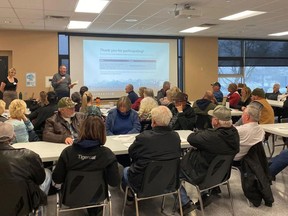County of Brant is proposing a monthly stormwater fee in certain areas

The County of Brant is asking the public to weigh in on a stormwater tax that would help uphold a system that includes drains, ditches and stormwater ponds.
Advertisement 2
Article content
The infrastructure prevents runoff water from weather events — like rain or melting snow — from causing damage such as flooding or water-quality issues, county staff told residents on Wednesday at the first of two public information meetings.
Article content
Some residents have already made their thoughts known in an online FAQ that county staff are responding to.
“How can you tax us on the weather? …What’s next, am I going to be taxed to fart?” one local named Rob posted on the EngageBrant online public forum.
The proposed plan — if accepted by council — would come into effect in 2025, costing homeowners in identified areas a $12 minimum monthly fee, with a minimum payment of just over $21 a month for industrial, commercial, institutional and multi-residential buildings.
Advertisement 3
Article content
Agricultural lands would be exempt, as they are covered under the provincial drainage act, Rob Walton, general manager of operations for the county, told attendees.
“There were some farm residents that came, concerned with a similar situation from Hamilton, and the ones that we talked to were happy to learn that they were not part of the areas considered for the utility fee,” a joint email from Walton and Andrea Bazzard, director of environmental services for the county, told The Spectator.
The infrastructure is currently funded through the general tax levy, however, that “status quo budget” is only intended to cover the “bare minimum” in terms of maintenance on the existing system, Bazzard told attendees.
Advertisement 4
Article content
A more “sustainable and equitable” way to manage it moving forward is needed, owing to a variety of factors, including new provincial legislation, regulatory requirements, aging infrastructure and “the increased frequency of severe weather events,” according to a multimedia presentation shown on Wednesday.
It was a tough pill to swallow for the 80 or so residents who came out to Burford Community Centre.
Locals from parts of the county like Burford, St. George, and Scotland expressed anger at receiving this information hot on the heels of an 8.7 per cent tax increase.
Others said they feel they’re constantly footing the bill for the town of Paris — parts of which carry a substantial flood risk due to the Grand River.
Bazzard assured attendees they would factor in this feedback, sharing it with advisors when bringing a report forward at the policy development committee meeting on May 7.
Residents who want to learn more or share their opinions, can do so at the next public information center on March 25 from 5:30 to 7:30 pm at Cainsville Community Centre, or through the public survey closing on April 6.
Celeste Percy-Beauregard is a Local Journalism Initiative Reporter based at the Hamilton Spectator. The initiative is funded by the Government of Canada.
Article content